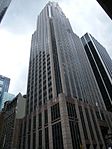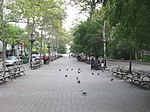Jacqueline Kennedy Onassis High School for International Careers

The Jacqueline Kennedy Onassis High School for International Careers, located at 120 West 46th Street in the Times Square neighborhood of Manhattan, New York City, was established in the 1970s in lower Manhattan as an all-girls annex to Murry Bergtraum High School. Its original goal was to offer young women a business education, then not readily available to female students, however it is now co-ed. The school was renamed in honor of former First Lady Jacqueline Kennedy Onassis in 1995, a year after her death. It is a part of the New York City Department of Education (NYCDOE). The building now occupied by the school was formerly the location of Performing Arts High School, the school on which the 1980 film Fame was based. In winter 1988, the vacant building caught fire during renovation. Its facade and several exterior walls survived; the interior needed complete reconstruction. Performing Arts High School moved to LaGuardia High School, and the 46th Street building reopened in 1995 as the Jacqueline Kennedy Onassis High School. The primary programs offered by the school include international business studies, virtual enterprise, hospitality and tourism, and accounting. Other programs include drama and dance.
Excerpt from the Wikipedia article Jacqueline Kennedy Onassis High School for International Careers (License: CC BY-SA 3.0, Authors, Images).Jacqueline Kennedy Onassis High School for International Careers
West 46th Street, New York Manhattan
Geographical coordinates (GPS) Address External links Nearby Places Show on map
Geographical coordinates (GPS)
| Latitude | Longitude |
|---|---|
| N 40.757694444444 ° | E -73.983333333333 ° |
Address
Onassis High School
West 46th Street 120
10036 New York, Manhattan
New York, United States
Open on Google Maps






